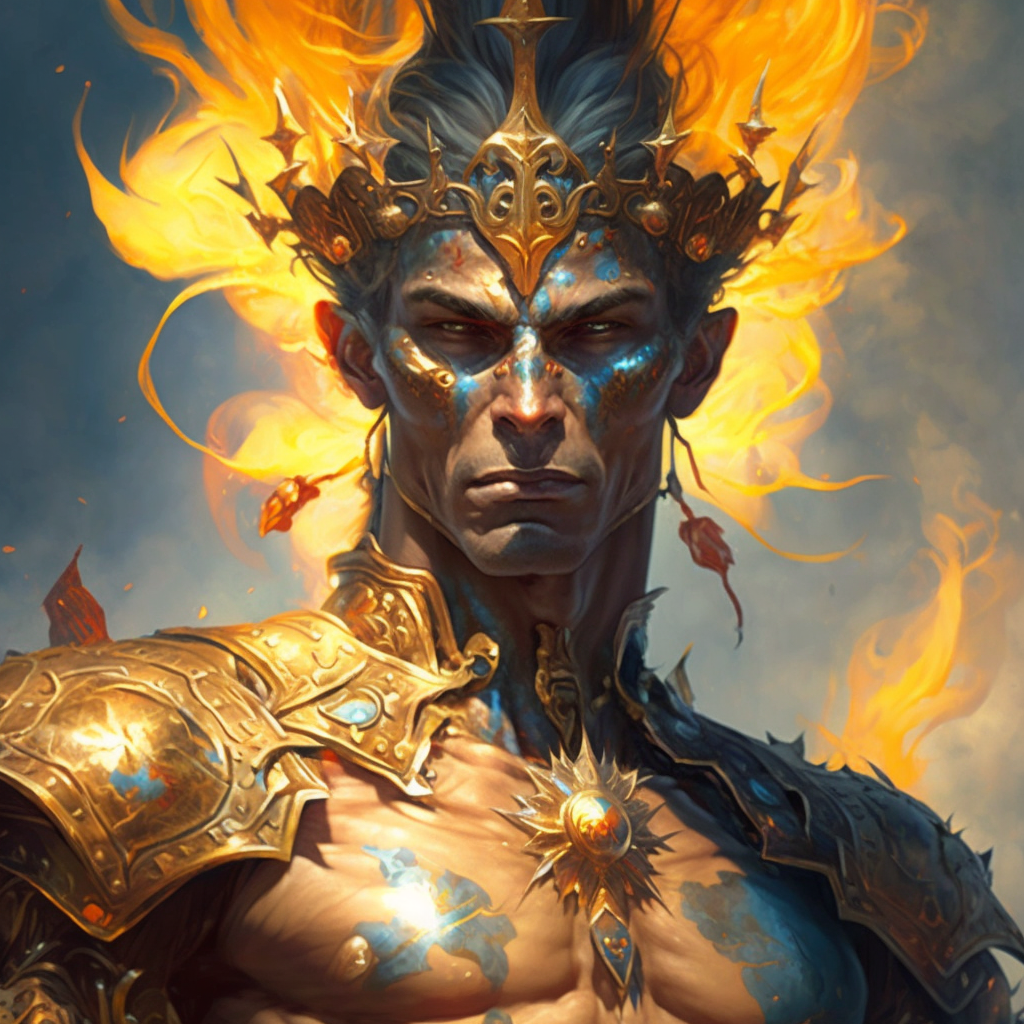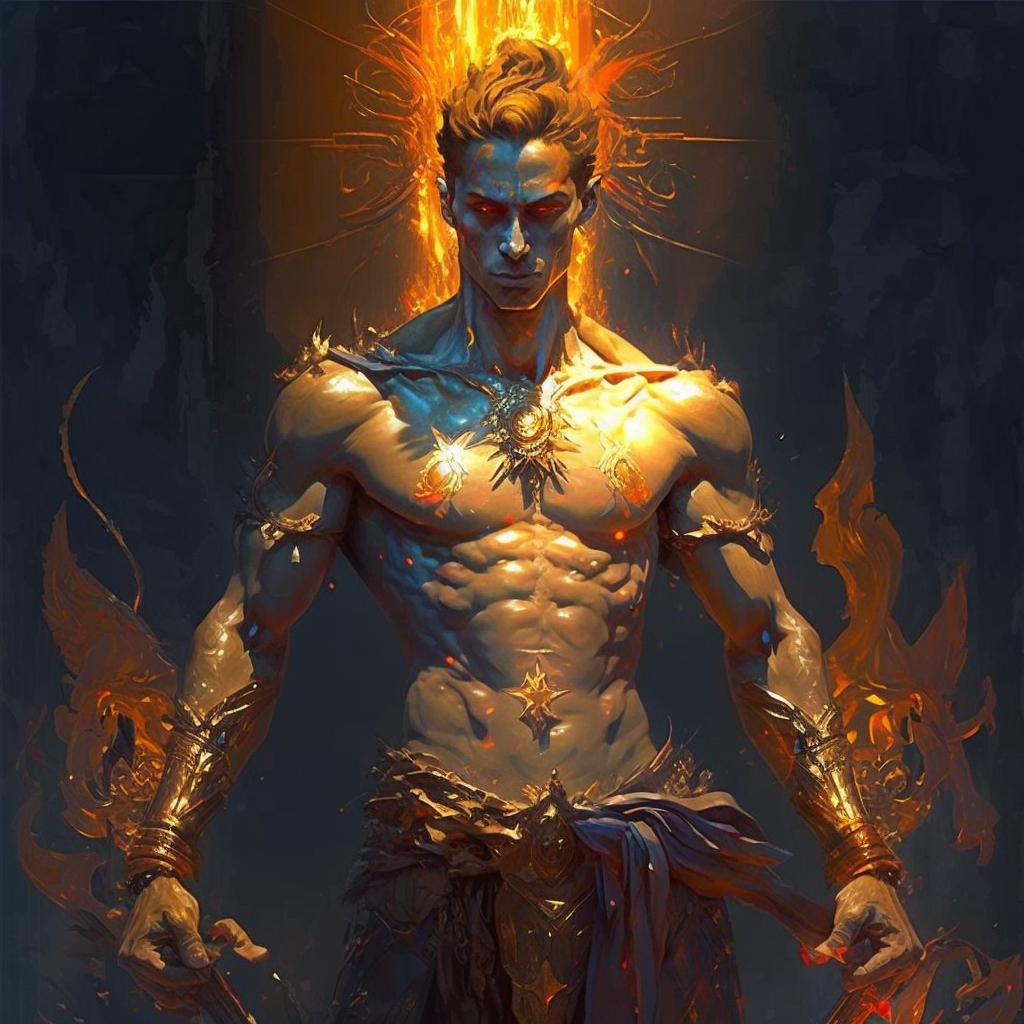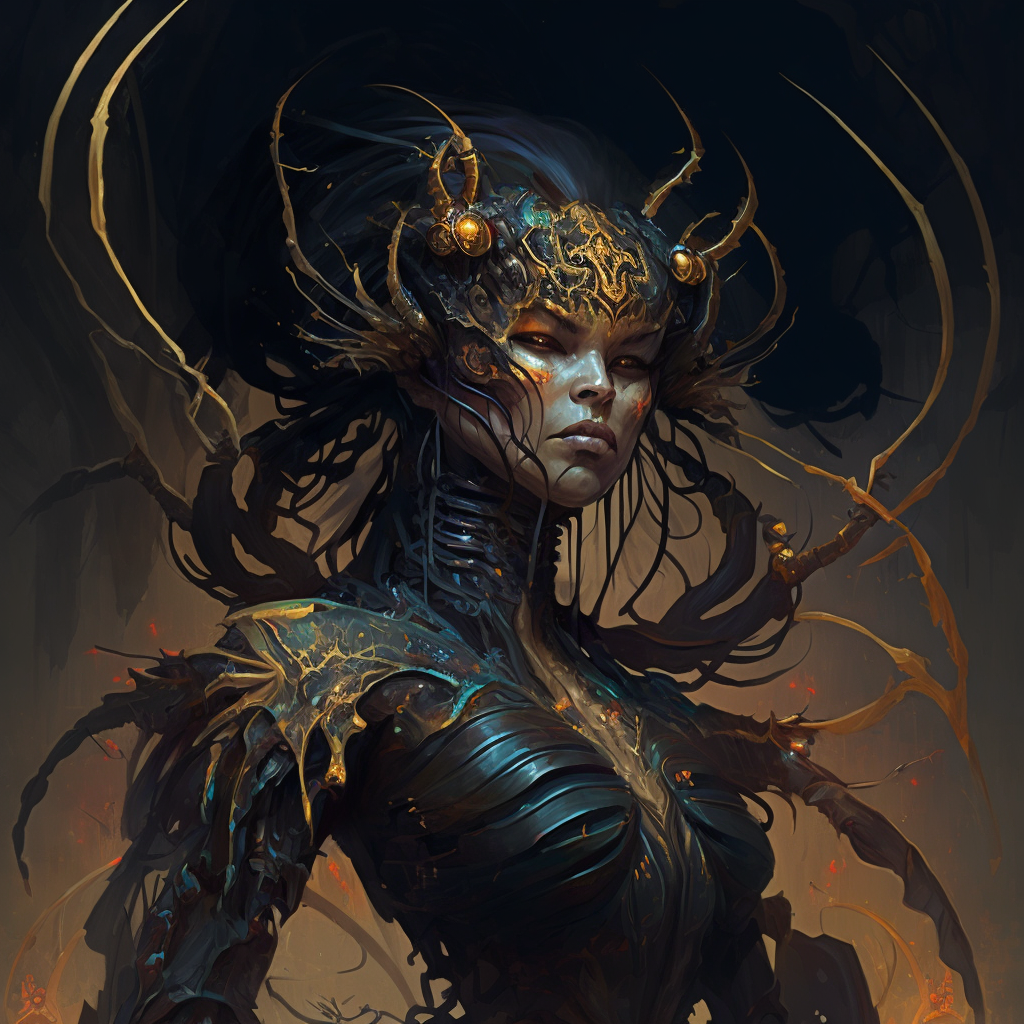Utu, “God of Justice and the Sun”
Utu is the ancient Mesopotamian god of the sun and justice.

- Pantheon: Mesopotamian Pantheon
- Deity Title: Utu, also known as Shamash
- Deity Symbol: A sun disk with rays emanating from it, often flanked by lions
- Home Plane: The Mesopotamian Underworld
- Deity Level: Intermediate deity
- Alignment: Lawful Neutral
- Aliases: Samas, Babbar, Shamash
- Superior: Anu (in some traditions)
- Traditional Allies: Anu, Enlil, Ishtar, Marduk
- Traditional Foes: Nergal, Ereshkigal
- Divine Artifact: A mace or staff made of gold, or a pair of scales
- Servants: Girtablullu (Scorpion men), The Igigi
- Servitor Creatures: Lions and other big cats
- Sacred Animal: The lion
- Manifestations: A humanoid figure with a radiant aura and a fiery sword, or as a lion-headed figure
- Signs of Favor: A feeling of warmth or light, an increase in strength or courage, or a vision of the sun
- Worshipers: Kings, judges, and other officials, as well as ordinary people seeking justice or protection
- Cleric Alignments: Lawful Neutral, Lawful Good, Neutral Good
- Specialty Priests: The Courtier of Shamash (a priest who acts as a liaison between the temple and the royal court), the Advocate of Shamash (a priest who acts as a judge or mediator in legal disputes), and the Exorcist of Shamash (a priest who specializes in exorcising evil spirits)
- Holy Days: The New Year Festival (celebrated in the spring), and the Festival of the Sun God (celebrated in the summer)
- Portfolio: Justice, truth, law, the sun, and protection
- Domains: Fire, Glory, Law, Nobility, Sun
- Favored Weapon: The mace or the staff
- Favored Class: Cleric
- Favored Race: Humans
- Duties of the Priesthood: Upholding the law, administering justice, protecting the people, and honoring the sun god
- Major Cult/Temple Sites: The temple of Shamash in Sippar, and the temple of Utu in Babylon
- Benefits: Priests of Utu gain access to powerful spells and abilities related to justice and protection, and they are highly respected members of their communities. They also have the support of the king and other officials, and may receive gifts and offerings from grateful worshipers.
Utu is a powerful being, revered by the people of ancient Mesopotamia as the god of the sun and justice. As a deity, Utu is often depicted as a majestic figure, radiating warmth and light, and wielding a mighty sword that represents his power over justice and retribution. Despite his awe-inspiring presence, Utu is also known for his compassion and his unwavering commitment to justice and fairness.
Utu’s role as a god of justice stems from his deep sense of responsibility for maintaining order and balance in the world. He is acutely aware of the consequences of injustice and the harm it can cause to individuals and societies alike. As a result, he is fiercely committed to ensuring that those who violate the laws of the universe are held accountable for their actions.
Utu’s desire to maintain order and balance in the world is rooted in his belief that this is the best way to promote happiness and well-being for all beings. He understands that when people are treated fairly and justly, they are more likely to be content and at peace with themselves and the world around them.
Despite his godly status, Utu is not immune to the trials and tribulations of mortal life. He faces challenges and obstacles just like any other being, and he understands the importance of perseverance and determination in overcoming these challenges. Through his actions, he seeks to inspire others to do the same, and to embrace the power of justice and fairness in their own lives.
Utu is a towering figure, with broad shoulders and a muscular build. His skin is radiant and golden, reflecting the warmth and power of the sun that he embodies. His eyes are a piercing blue, sparkling with intelligence and wisdom, and his face is handsome and regal, exuding an aura of authority and command. He wears a crown of flames, symbolizing his connection to the sun, and he wields a sword of light that glows with an otherworldly energy. His presence is awe-inspiring, and those who gaze upon him cannot help but feel a sense of reverence and respect.
Ultimately, Utu’s goal is to create a world where justice and fairness are the guiding principles, and where all beings can live in harmony and peace with one another. He understands that this is a lofty goal, but he is willing to work tirelessly towards it, driven by his deep sense of compassion and his unwavering commitment to justice and fairness.
Utu, God of Justice and the Sun

Medium deity, Lawful Neutral
| Strength | Dexterity | Constitution | Intelligence | Wisdom | Charisma |
|---|---|---|---|---|---|
| 30 (+10) | 30 (+10) | 30 (+10) | 30 (+10) | 30 (+10) | 30 (+10) |
Armor Class: 40 (divine armor)
Hit Points: 1,500 (divine)
Speed: 120 ft., fly 240 ft.
Skills: Insight +30, Perception +30, Religion +30
Senses: Truesight 120 ft., passive Perception 40
Languages: All
Challenge Rating: 35 (200,000 XP)
Traits:
- Divine Being: Immune to nonmagical weapons, immune to charm, exhaustion, frightened, and paralyzed conditions.
- Sun God: Can summon daylight at will within a 1-mile radius.
- Judge of the Gods: Can cast any spell from the Law, Nobility, or Sun domains at will.
- Protector: Has an aura of protection that extends to a 10-mile radius, granting resistance to fire damage and a +5 bonus to all saving throws to allies.
- Divine Weapon: Wields a mace made of pure gold that deals 4d12 bludgeoning damage and 4d12 radiant damage.
- Divine Artifact: Possesses a pair of scales that can measure the balance of justice in any situation and reveal any falsehoods.
Actions:
- Multiattack: Utu can make three attacks with its mace or use its Divine Bolt and make two attacks with its mace.
- Mace: Melee Weapon Attack: +30 to hit, reach 10 ft., one target. Hit: 38 (4d12 + 10) bludgeoning damage and 38 (4d12 + 10) radiant damage.
- Divine Bolt: Ranged Spell Attack: +30 to hit, range 120 ft., one target. Hit: 50 (10d10) radiant damage.
- Judgment: Utu can cast Power Word Kill at will.
- Summon Masaru: Utu can summon 1d4 Masaru demons to fight for him.
Legendary Actions:
Utu can take three legendary actions per turn, choosing from the options below. Only one legendary action option can be used at a time, and only at the end of another creature’s turn. Utu regains spent legendary actions at the start of its turn.
- Blinding Light: Utu emits a blinding light in a 60-foot cone. Creatures within the area must make a DC 30 Constitution saving throw or be blinded for one minute.
- Divine Healing: Utu can heal itself or a creature it can see within 60 feet for 200 hit points.
- Divine Protection: Utu can grant an ally within 60 feet resistance to all damage for one minute.
Divine Lair Actions:
Utu’s temple becomes an extension of its divine will, allowing it to bend reality within its walls. These actions can be used once per round and cannot be used on consecutive turns.
- Solar Flare: The temple is engulfed in a brilliant light that deals 10d10 radiant damage to all creatures within it. A DC 30 Constitution saving throw halves the damage.
- Divine Justice: The temple is filled with a sense of righteousness that forces all creatures within it to make a DC 30 Wisdom saving throw or become stunned for one round.
- Sunburst: The temple is illuminated with a burst of sunlight that deals 20d6 radiant damage to all creatures within it. A DC 30 Constitution saving throw halves the damage.
Regional Effects:
The presence of Utu causes the following effects within a 10-mile radius of its temple:
- Divine Light: The area is bathed in sunlight, even at night or in caves.
- Justice Prevails: All attempts to deceive, lie, or cheat within the area fail, as the scales of justice are tipped in favor of the truth. Sunfire: All fire damage within the area is maximized.
- Divine Intervention: Utu has a 10% chance per day to intervene in any situation within the area, using any of its abilities or spells as it sees fit.
Currently
Utu, the Mesopotamian god of the sun and justice, has always been a powerful force in the world, but his influence has waxed and waned over the centuries. In the 1450s, however, Utu has once again become a prominent figure, as the world is in the midst of a period of great change and upheaval.
As Europe emerges from the Middle Ages and enters the Renaissance, the world is being transformed in profound ways. New ideas, new technologies, and new ways of thinking are reshaping the world, and Utu is watching it all with great interest.
In particular, Utu is intrigued by the rise of humanism, a movement that places a strong emphasis on individualism, reason, and the potential of human beings to shape their own destiny. He sees in this movement a reflection of his own ideals of justice and fairness, and he is drawn to its vision of a world in which all beings are treated with dignity and respect.
At the same time, Utu is also aware of the dangers that lurk beneath the surface of this new era. The lust for power and wealth that has always plagued humanity is still very much alive, and there are many who are willing to exploit others in order to gain it.
To counter this threat, Utu has taken on a new mission: to inspire and empower those who are working to build a more just and equitable world. He travels the world, appearing to those who are struggling to make a difference, and offering them guidance and support.
In the 1450s, Utu finds himself in Italy, where the Renaissance is in full swing. He is fascinated by the work of the great artists and thinkers of the age, and he spends much of his time engaging with them and offering his own insights and perspectives.
He is particularly drawn to the work of Leonardo da Vinci, whom he sees as a kindred spirit. He is impressed by da Vinci’s commitment to using his talents for the betterment of humanity, and he sees in him a potential ally in his own mission to promote justice and fairness.
In the end, Utu’s goal is a simple one: to create a world in which all beings are treated with dignity and respect, and where justice and fairness are the guiding principles. He knows that this is a lofty goal, but he is willing to work tirelessly towards it, driven by his deep sense of compassion and his unwavering commitment to justice and fairness.
Utu’s Girtablullu
The Girtablullu is a towering monstrosity with a scorpion-like head, humanoid arms with pincers, and a lower body with a venomous stinger, radiating an aura of primal fear.

Large monstrosity, neutral
Armor Class: 17 (natural armor)
Hit Points: 120 (16d10 + 32)
Speed: 40 ft.
| STR | DEX | CON | INT | WIS | CHA |
|---|---|---|---|---|---|
| 20 (+5) | 16 (+3) | 14 (+2) | 6 (-2) | 10 (+0) | 6 (-2) |
Skills: Perception +4, Survival +4
Senses: darkvision 60 ft., passive Perception 14
Languages: understands Common but can’t speak
Challenge Rating: 8 (3,900 XP)
Actions
- Multiattack. The Girtablullu makes two attacks: one with its pincer and one with its tail.
- Pincer. Melee Weapon Attack: +9 to hit, reach 10 ft., one target. Hit: 19 (3d8 + 6) bludgeoning damage.
- Tail Sting. Melee Weapon Attack: +9 to hit, reach 10 ft., one target. Hit: 14 (2d8 + 5) piercing damage and the target must succeed on a DC 16 Constitution saving throw or take 21 (6d6) poison damage and become poisoned for 1 minute. A poisoned target can repeat the saving throw at the end of each of its turns, ending the effect on itself on a success.
Scorpion Carapace. The Girtablullu has resistance to bludgeoning, piercing, and slashing damage from nonmagical attacks that aren’t adamantine.
Keen Senses. The Girtablullu has advantage on Wisdom (Perception) checks that rely on sight, hearing, or smell.
Steadfast. The Girtablullu has advantage on saving throws against being charmed or frightened.
Sun’s Fury. When the Girtablullu is in direct sunlight, its pincer and tail attacks deal an additional 7 (2d6) radiant damage.
Legendary Actions
The Girtablullu can take 3 legendary actions, choosing from the options below. Only one legendary action option can be used at a time and only at the end of another creature’s turn. The Girtablullu regains spent legendary actions at the start of its turn.
- Pincer Attack. The Girtablullu makes a pincer attack.
- Tail Sting. The Girtablullu makes a tail sting attack.
- Terrifying Presence (Costs 2 Actions). The Girtablullu roars or hisses loudly. Each creature within 60 feet of the Girtablullu that can hear it and isn’t immune to being frightened must make a DC 16 Wisdom saving throw. On a failure, the creature is frightened of the Girtablullu for 1 minute. The creature can repeat the saving throw at the end of each of its turns, ending the effect on itself on a success.
Lair Actions
On initiative count 20 (losing initiative ties), the Girtablullu can take a lair action to cause one of the following magical effects:
- Earthquake. The Girtablullu can cause the ground to shake violently, creating an earthquake effect in a 60-foot radius centered on the Girtablullu. Each creature on the ground within the area must make a DC 16 Dexterity saving throw or be knocked prone.
- Summon Scorpions. The Girtablullu can summon 2d4 giant scorpions to appear within 60 feet of the Girtablullu. These scorpions are friendly to the Girtablullu and obey its commands.
- Blinding Sandstorm. The Girtablullu can create a blinding sandstorm in a 60-foot radius centered on the Girtablullu. The sandstorm heavily obscures the area, and each creature within it must make a DC 16 Constitution saving throw or be blinded until the end of its next turn.
Girtablullu is a towering monstrosity that stands at least eight feet tall, with a thick exoskeleton covered in black, scaly armor that shines in the light. Its head is that of a giant scorpion, with sharp mandibles and a pair of multifaceted eyes that glow with a malevolent light. Its arms are humanoid in shape, with massive pincers that can crush stone or rend flesh with equal ease. Its lower body is that of a giant scorpion, with a long, flexible tail ending in a wicked stinger that drips with venom.
As it moves, the Girtablullu scuttles across the ground with an unsettling grace, its movements quick and fluid despite its massive size. Its chitinous armor clacks and scrapes against itself, making a sound like grinding metal that sends shivers down the spines of those nearby. Its multifaceted eyes scan its surroundings with an unnerving intensity, seemingly aware of every detail in its field of vision.
The Girtablullu radiates an aura of primal fear, as if it embodies the very essence of the wild and untamed. Its presence is an affront to civilized sensibilities, a reminder that there are things in the world that cannot be tamed or controlled. In its presence, even the bravest warrior may find their nerve failing, and only the most stalwart and courageous can hope to stand against it and emerge victorious.

 Buy me a coffee
Buy me a coffee